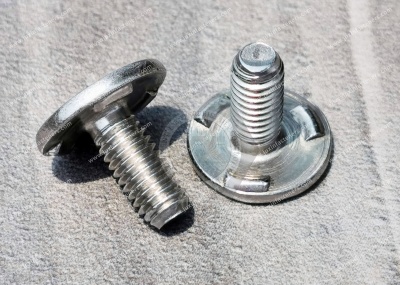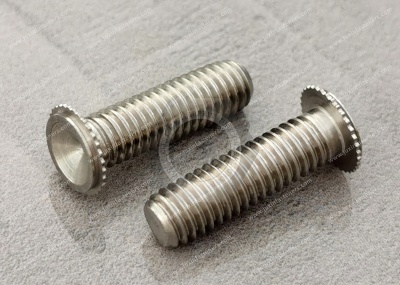Call Us
+86 136 6007 9809
Call Us
+86 136 6007 9809
Jul. 10, 2024
Why are stainless steel screws magnetic?
People often think that the magnet adsorption of stainless steel, to verify its strengths and weaknesses and authenticity, does not suck non-magnetic; that is good; the real thing; suckers have magnetic and it is considered to be counterfeit fake. This is a highly one-sided, unpractical, and incorrect identification method. Stainless steel screws of many kinds, at room temperature according to the organizational structure, can be divided into several categories:
1. Austenitic: such as 304, 321, 316, 310, etc.
2. Martensitic or ferritic type: such as 430, 420, 410, and so on;
The austenitic type is non-magnetic or weakly magnetic, and martensitic or ferritic is magnetic.
Usually used as decorative pipe plate stainless steel, most austenitic type 304 material is generally non-magnetic or weakly magnetic. However, due to smelting caused by fluctuations in the chemical composition or processing state, it may also appear magnetic, but this can not be regarded as impostor or unqualified. What is the reason for it?
It is mentioned above that austenite is non-magnetic or weakly magnetic, and martensite or ferrite is magnetic due to smelting composition segregation or improper heat treatment, which will cause austenitic 304 stainless steel in a small amount of martensite or ferrite organization. In this way, 304 stainless steel will have a weak magnetism.
This tells us that stainless steel with weak magnetism or complete non-magneticity should be identified as 304 or 316 material; if its magnetism is the same as carbon steel, showing strong magnetism, the judgment is not 304 material.
(1) The iron content of stainless steel
Stainless steel generally refers to the amount of chromium in 10.5% or more of the alloy steel and its excellent corrosion resistance in the industrial and civil fields with a wide range of applications. Stainless steel contains a certain amount of iron; some even contain up to 70% iron, which is one of the reasons why stainless steel will be magnetic.
(2) The formation mechanism of magnetism
The higher the iron content in stainless steel, the stronger the magnetism. In the production process, the lattice structure of stainless steel changes as the temperature rises. When the temperature of stainless steel increases to the corresponding "critical temperature," the iron element will become magnetic ferrite from the non-magnetic austenite phase, thus forming the magnetic properties of stainless steel
(3) Magnetic properties of different types of stainless steel
The magnetism of stainless steel is related to its type; austenitic stainless steel is a non-magnetic stainless steel commonly used in kitchen utensils, medical equipment, and other fields requiring high corrosion resistance and hygiene. Martensitic stainless steel, on the other hand, is usually magnetic due to its high iron content. It is commonly used in mechanical industries, such as manufacturing blades and knives.
Overall, stainless steel screws will be magnetic because of the presence of iron and the formation mechanism of magnetism. To avoid magnetic stainless steel, you can use chrome-nickel alloy stainless steel. Chrome-nickel alloy stainless steel does not contain iron, so it is non-magnetic stainless steel.
Applications
Stainless steel screws are widely used in machinery, petrochemicals, communications, chemical industry, construction industry, electric power, textile, sports equipment, papermaking, sewage treatment, ships, automobiles and other industries.
18-8 Stainless Steel Phillips Rounded Head Screws for Sheet Metal:18-8 stainless steel screws have good chemical resistance and may be mildly magnetic. They penetrate 0.025" and thinner sheet metal. Length is measured from under the head.
Black-oxide stainless steel screws have a dark surface color.
18-8 stainless steel screws have good chemical resistance and may be mildly magnetic. They penetrate 0.025" and thinner sheet metal. Length is measured from under the head.
Black-oxide stainless steel screws have a dark surface color with threads the same diameter as the shoulder, and these screws can handle heavy loads. Made from 18-8 stainless steel, they have good chemical resistance and may be mildly magnetic. A standard shoulder with an undersized tolerance allows them to fit most machinery and equipment. They're often used to guide or align components and as an axle or pivot point.
Black-oxide stainless steel screws have a matte-black finish.


Stainless Steel Socket Head Screws with Split Lock Washer: Screws are 18-8 stainless steel for good chemical resistance. They may be mildly magnetic. Also known as Sems screws, they have a permanently attached but freely rotating split lock washer that adds tension to resist loosening from vibration. All screws meet ASTM F837 specifications and testing requirements for material quality. Length is measured from under the head.
Coarse threads are the industry standard; choose these screws if you don't know the threads per inch. Fine threads are closely spaced to prevent loosening from vibration. They are not compatible with coarse threads.
For high-quality 18-8 stainless steel pan head Phillips screws and professional technical support, don't hesitate to contact us at adelajonly@gmail.com or visit our website at: https://www.juxinfasteners.com.
How to carry out the passivation of stainless steel screws
Contact Us
Tel.:
+86 020 8621 0320
+86 020 3121 6067
Technical Support:
Navigation
SEND INQUIREY